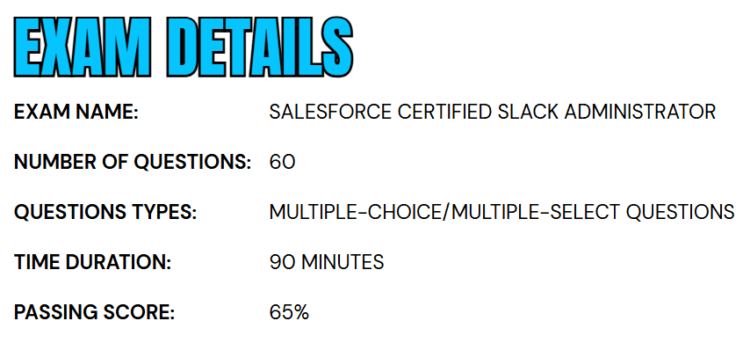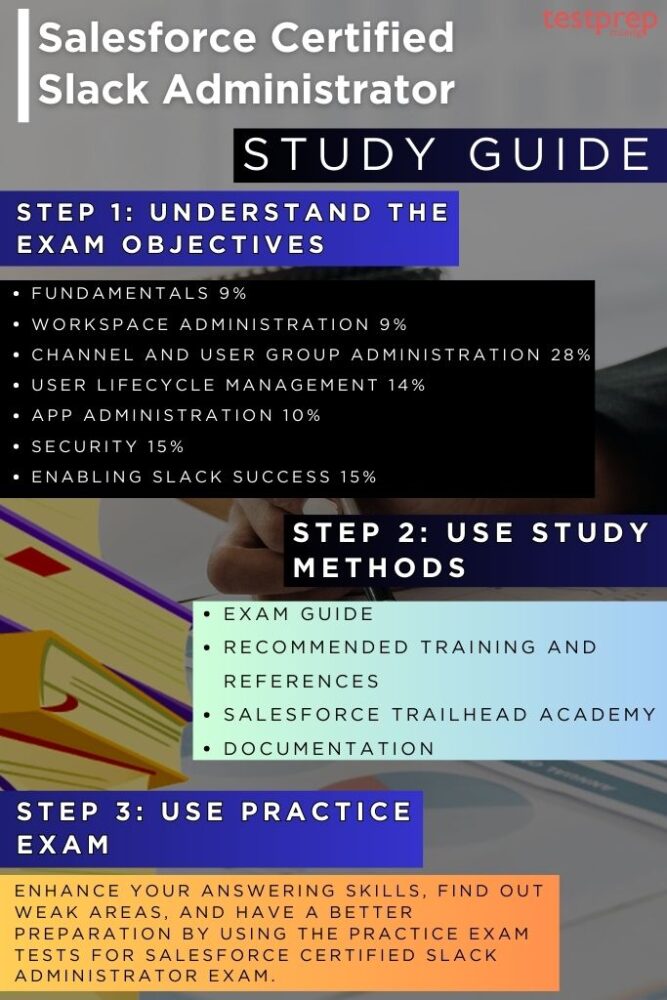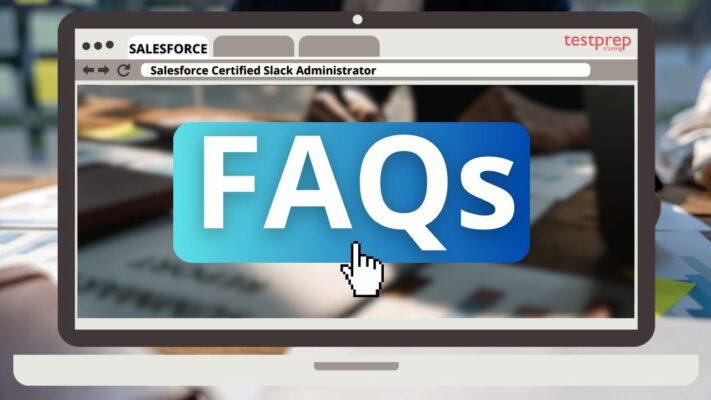Salesforce Certified Slack Administrator

The Salesforce Certified Slack Administrator certification is designed for professionals who possess the expertise to configure Slack and optimize its features to enhance collaboration, communication, and productivity across an organization. This credential validates a comprehensive understanding of Slack’s capabilities—spanning end-user functionalities to administrative configuration and management.
Target Audience
Ideal candidates for this certification are experienced Slack Administrators who can confidently implement, configure, and manage Slack environments across various plans and organizational needs. These professionals should be adept at recommending and applying appropriate policies, settings, and features to meet diverse business use cases.
Knowledge Area
Candidates are expected to demonstrate knowledge and hands-on experience in the following key areas:
- Administrator roles and responsibilities
- Slack architecture and infrastructure
- User provisioning and lifecycle management
- Workspace settings and governance policies
- Channel structure and collaboration models
- App approval and integration processes
- Data security and compliance best practices
- Process automation and design
- Driving user adoption and engagement
Additionally, candidates should have a minimum of 6 months of practical experience as a Slack Administrator.
Exam Details

The Salesforce Certified Slack Administrator exam is composed of 60 multiple-choice and multiple-select questions, with a total duration of 90 minutes to complete the assessment. To pass the exam, candidates must achieve a minimum score of 65%. The exam is available in a proctored format and can be taken either onsite at a designated testing center or online through a secure virtual environment. It is important to note that the use of hard-copy or online reference materials is strictly prohibited during the exam. There are no formal prerequisites required to take the exam, making it accessible to professionals ready to validate their Slack administrative expertise.
Course Outline
The Salesforce Certified Slack Administrator Exam is designed to assess a candidate’s comprehensive understanding, practical experience, and proficiency in administering and managing Slack within an organization. The exam evaluates the ability to configure, optimize, and support Slack environments across a variety of use cases and business needs. Specifically, it measures a candidate’s knowledge and skills across a set of defined objectives that reflect real-world scenarios, best practices, and core administrative responsibilities. These objectives encompass both foundational and advanced topics that are critical to successfully deploying and managing Slack as a collaborative communication platform. The objectives include:
1. Fundamentals (9%)
- Summarize the key privileges and responsibilities of each Slack user role.
- Identify the unique features of each Slack paid plan.
- Identify the common responsibilities of Slack Admin and Owner roles.
- Identify workspace and org-level settings and dashboards.
2. Workspace Administration (9%)
- Determine when to create a workspace to meet the needs of an organization.
- Manage the workspace creation and approval process.
- Choose a workspace visibility setting that meets the needs of the members and organization.
- Prepare an Enterprise Grid design that meets the needs of the members and organization.
- Recommend how to consolidate workspaces.
3. Channel and User Group Administration (28%)
- Set up and administer Slack channels.
- Recommend when to use a channel, a direct message (DM), or a group DM.
- Recommend when to use a public or private channel.
- Recommend when to use multi-workspace channels.
- Administer channel posting permissions.
- Given a business case, recommend when to share a channel with an outside organization.
- Demonstrate how to manage connections, channels, and DMs with outside organizations.
- Establish channel-naming guidelines and set recommended prefixes to meet the needs of an organization.
- Administer policies to manage the status or state of channels (for example, delete, archive, and convert).
- Recognize when to use and how to set up Slack user groups.
4. User Lifecycle Management (14%)
- Implement the best authentication option based on the Slack plan and an organization’s requirements.
- Recommend a process for new account creation for different use cases.
- Recommend when to use a system for cross-domain identity management (SCIM) versus just-in-time (JIT) to provision users.
- Recommend a process for getting new users into the right workspace(s) and channels.
- Demonstrate the two ways full member accounts can be deactivated (manual deactivation versus SCIM deprovisioning).
- Create a guest user request and approval process.
5. App Administration (10%)
- Summarize the value of interoperability for decision makers and end users.
- Use Workflow Builder to automate routine tasks and manual business processes.
- Understand the App installation process.
- Set up and manage an app-approval process.
6. Security (15%)
- Identify Slack product security features and settings to meet an organization’s security needs.
- Describe how Slack prioritizes security governance, risk management, and compliance and identify examples of each.
- Describe product features that manage access and mobile devices to meet specific business needs.
- Recommend product features that protect and manage sensitive data to meet specific business needs.
- Recommend product features that govern information to meet specific business needs.
- Recommend when to audit user activity in Slack.
7. Enabling Slack Success (15%)
- Develop a vision and identify goals for Slack at an organization.
- Use the analytics dashboard to track Slack usage.
- Make recommendations based on analytics data (for example, channel archival, work with Slack Champions, publish a Slack etiquette guide).
- Build a Slack team to maintain a workspace or org based on best practices.
- Enable admins to promote Slack as the Digital HQ for their organization.
- Promote ongoing member enablement and engagement with specific programs and resources.
Salesforce Certified Slack Administrator: FAQs
Salesforce Exam Candidate Code of Conduct
At Salesforce, maintaining the integrity and security of our certification program is a shared responsibility. As a participant in the Salesforce Credentialing Program, you are required to acknowledge and adhere to the terms outlined in the Salesforce Credential and Certification Program Agreement.
– Your Responsibilities as a Program Participant
To uphold the integrity of the certification process, participants are expected to:
- Utilize official Salesforce study resources, including Trailhead modules, trailmixes, certification exam guides, and Trailhead Academy courses, to properly prepare for exams.
- Engage with the Trailblazer Community by joining Community Groups, connecting with peers, and seeking mentorship or study support.
- Understand and follow exam guidelines, whether taking the exam online with a proctor or at a designated test center.
- Report any suspicious or unethical behavior that could compromise credential security by submitting a case to the Credential Security team.
– Prohibited Activities
To ensure a fair and secure certification process, the following actions are strictly prohibited:
- Sharing, requesting, or using actual exam questions, answers, or Superbadge solutions.
- Soliciting or providing unauthorized assistance during an exam.
- Participating in any conduct that violates the Salesforce Credential and Certification Program Agreement.
– Consequences of Non-Compliance
Violations of the program policies may result in serious consequences, including but not limited to:
- Cancellation of scheduled certification exams
- Suspension from online proctored exams
- Temporary or permanent ban from participating in certification exams
- Revocation of earned certifications and Superbadges
- Removal from the Salesforce Credentialing Program and the Trailblazer Community
Salesforce Certified Slack Administrator Exam Study Guide

1. Understand the Exam Guide
The exam guide serves as a comprehensive resource to help you determine your readiness for the Salesforce Certified Slack Administrator Exam. It outlines key information about the intended audience, recommended training resources, and detailed exam objectives to support your preparation and increase your likelihood of success. By clearly defining what to expect and what is expected of you, the guide empowers candidates to take a focused and informed approach to exam readiness. To optimize your chances of passing, Salesforce strongly encourages a balanced preparation strategy that includes real-world hands-on experience, participation in relevant training courses, and dedicated self-study.
2. Salesforce Recommended Training and References
Salesforce recommends a well-rounded preparation strategy to ensure success on the Salesforce Certified Slack Administrator Exam. This approach should include a combination of hands-on experience, successful completion of Salesforce-approved training courses, active participation in Trailhead trails and trailmixes, and focused self-study based on the topics. Gaining practical experience in administering Slack, combined with structured learning and self-paced study, will help reinforce your understanding of key concepts and real-world scenarios covered on the exam. To support your preparation, the following self-study materials are highly recommended:
– Trailmix: Preparing for the Salesforce Administrator Exam
This curated learning path includes essential modules, hands-on projects, and recommended resources that align with the exam objectives. It’s designed to build both foundational knowledge and practical skills in Slack administration, making it an invaluable tool for anyone aiming to earn this certification.
3. Utilize Salesforce Trailhead Academy
For a more structured and in-depth learning experience, consider enrolling in courses offered by the Salesforce Trailhead Academy. These expert-led training programs are designed to complement your hands-on experience and self-study efforts by providing guided instruction on key concepts covered in the Salesforce Certified Slack Administrator exam. Trailhead Academy courses offer interactive learning, real-world scenarios, and direct access to certified instructors, helping you build confidence and deepen your understanding of Slack administration best practices. Leveraging these resources can significantly enhance your readiness and increase your chances of exam success.
4. Make Use of Official Documentation
In addition to hands-on practice and guided training, it’s essential to thoroughly review the official Slack and Salesforce documentation as part of your exam preparation. These resources provide detailed, up-to-date information on features, configuration options, administrative settings, and best practices relevant to the Salesforce Certified Slack Administrator exam. Documentation can help clarify complex topics, reinforce your understanding of key functionalities, and serve as a reliable reference when preparing for real-world use cases. Regularly consulting official documentation ensures you stay aligned with the latest platform updates and exam expectations.
5. Become Part of Study Groups/Communities
Joining study groups and online communities, such as the Trailblazer Community, is a valuable way to enhance your preparation for the Salesforce Certified Slack Administrator exam. Engaging with fellow learners, certified professionals, and mentors allows you to exchange knowledge, ask questions, and gain new perspectives on challenging topics. These communities often share study tips, real-world scenarios, and exam strategies that can deepen your understanding and boost your confidence. Participating in study groups also fosters accountability and motivation, helping you stay focused and on track throughout your certification journey.
6. Take Practice Exam Tests
Incorporating practice exams into your study plan is a critical step toward successfully earning your Salesforce Certified Slack Administrator credential. Practice tests help you familiarize yourself with the exam format, question style, and time constraints, allowing you to assess your readiness and identify areas that need improvement. By simulating the actual exam experience, you can build confidence, improve time management, and reinforce your understanding of key concepts. Regularly reviewing your results and revisiting weak areas will help ensure you’re well-prepared when it’s time to take the official certification exam.



